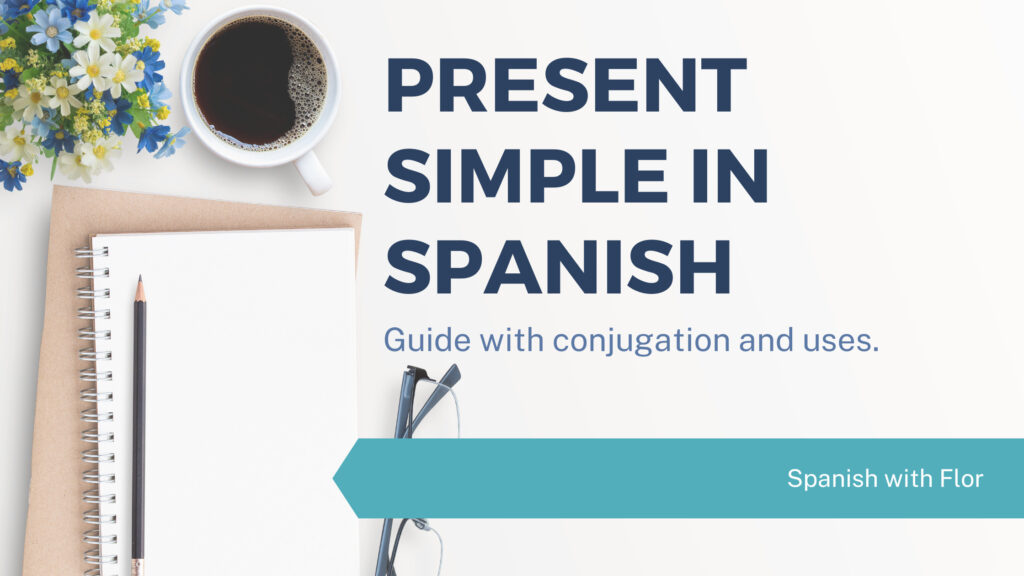The present simple in indicative in Spanish, known as “el presente del indicativo,” is used to describe events and actions happening during the current time. It is also used to express absolute statements, facts, and universal truths. This tense is used to speak about actions in the present and near future.
Students need to learn the present simple in indicative in Spanish because it is the most commonly used tense in the language. Mastering this tense enables students to communicate about daily routines, express general truths, and describe ongoing actions. Additionally, it forms the foundation for learning more complex tenses and grammatical structures in Spanish.
In this article I’ll share with you uses, how to conjugate and form the present simple in Spanish with examples, enjoy!
We use the present simple in Spanish to talk about:
- descriptions
Micaela es alta. – Micaela is tall
Juan es muy inteligente. – Juan is very smart
Yo soy joven. – I’m young
- routines
Me levanto a las 8 de la mañana. – I get up at 8 am in the morning
Tomo el desayuno a las 8.30. – I have breakfast at 8.30
Ella trabaja de lunes a viernes. – She works from Monday to Friday
- habits
Mi esposa hace ejercicio los lunes. – My wife workouts on Mondays
Mis hijos juegan al fútbol. – My children play football
En mi tiempo libre, leo el periódico. – On my free time, I read the newspaper
Present Simple with ESTAR, SER, IR
| Pronouns | ESTAR | SER | IR |
| yo | estoy | soy | voy |
| tú | estás | eres | vas |
| él / ella / usted | está | es | va |
| vos* | estás | estás | vas |
| nosotros / -as | estamos | somos | vamos |
| ellos / -as / ustedes | están | son | van |
| vosotros / -as | estáis | sóis | váis |
The negative form in Spanish is very simple! You only need to add NO before the verb, look at these examples:
- No soy holandesa.
- Tú no te llamas Marcos.
- No tiene hijos.
- No somos estudiantes
- No son de Paraguay.
How to make questions in the Present Simple
In Spanish we always use two question marks: ¿? Luckily we don’t have to change the order of the words. However, we have to change the intonation (rising) for questions. Have a look at these examples.
- ¿Te llamas Marcos? – Are you Marcos?
- ¿Tiene dos hijos? – Do you have two children?
- ¿Son estudiantes? – Are you students?
- ¿Ustedes son de Paraguay? – Are you from Paraguay?
How to conjugate verbs in the Present Simple
There are two types of verbs: regular and irregular. In the table below you can see how the verb changes for each pronoun.


Examples of the the present Simple
- Yo puedo hablar idiomas.
- ¿Quieres una taza de té?
- Nosotras somos griegas.
- Ellos no entienden francés.
- Hago ejercicio todos los martes y jueves.
- ¿Ustedes van a la escuela?
- Mi madre trabaja en el banco.
- ¿Eres una secretaria?
- Ella vive con su esposo y sus hijos.
- Los viernes como con mis padres en un restaurante.
Spanish Present Simple Practise for Beginners
Practise Spanish verbs in the present simple with this interactive exercise!
Practise Spanish regular and irregular verbs
Other uses of the Present Simple in Spanish
It’s also used to describe actions which took place in the past when describing historical events.
Examples:
- La guerra comienza en 1978
- La reina se casa a los 18 años.
It’s used in newspapers and recounting the news.
Examples:
- Joven muere en accidente.
- Hombre gana un millón en el Lotto.
It’s used to express actions that will take place in the immediate future, it’s accompanied by time phrases like: mañana, después, el jueves, etc.
Examples:
- Nos vemos mañana.
- Te llamo a tu casa después.
- El jueves no trabajo.
In the imperative mood, to give orders. We conjugate the verb in the 3rd person singular (ella, él, usted)
Examples:
- Camina más rápido.
- Habla despacio.
To talk about facts that are always true.
Examples:
- La Tierra gira alrededor del sol.
- El agua hierve a 100 grados.
When we talk about idiomatic expressions, proverbs and aphorisms.
Examples:
- El dinero no es todo.
- Al que Madruga, Dios lo ayuda.
If you are looking to start your Spanish learning, I can help you!
Join the Spanish with Flor Basic Spanish Course where I will teach you all the basics to kickstart your Spanish!


Hi there! I’m Flor, and I’m thrilled to be able to help you with your Spanish! I’m a Spanish online teacher and course creator from the vibrant city of Buenos Aires, Argentina. Whether you’re just starting your language learning journey or looking to further enhance your skills, I’m here to guide you every step of the way. Let’s embark on this exciting learning adventure together!

